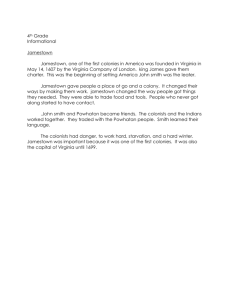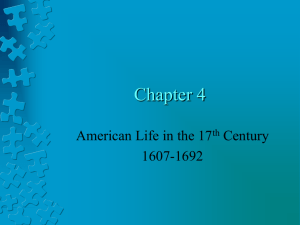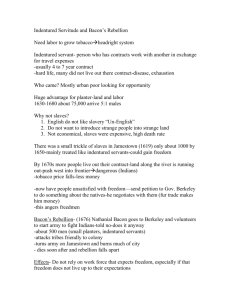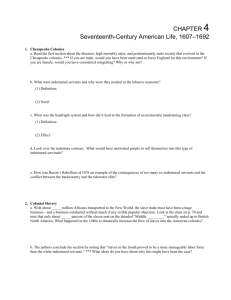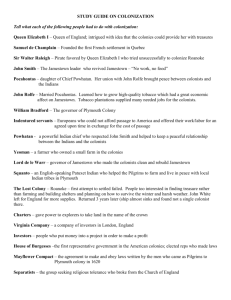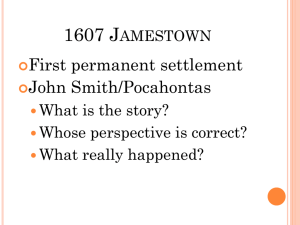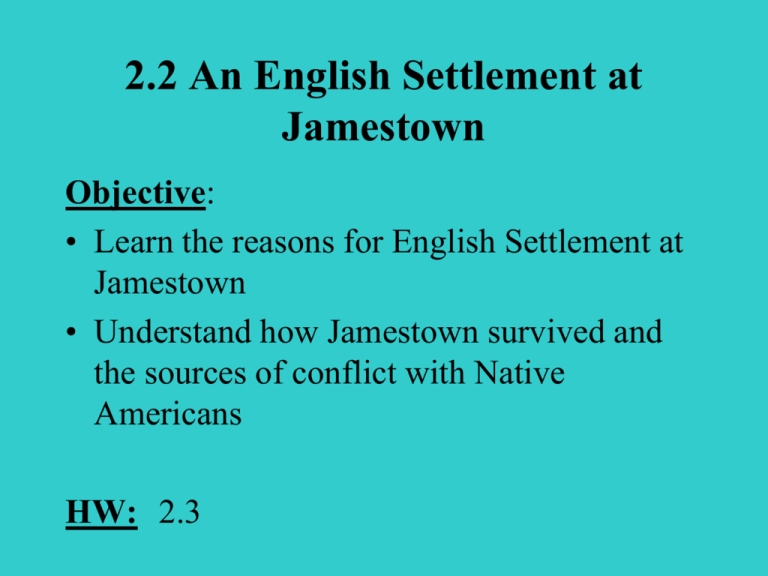
2.2 An English Settlement at
Jamestown
Objective:
• Learn the reasons for English Settlement at
Jamestown
• Understand how Jamestown survived and
the sources of conflict with Native
Americans
HW: 2.3
Armada Portrait of
Elizabeth I
Armada Portrait of Elizabeth I
(By kind permission of the Marquess of Tavistock and Trustees of the Bedford Estate)
Copyright © Houghton Mifflin Company. All rights reserved.
Armada Portrait of
Elizabeth I
Armada Portrait of Elizabeth I
(By kind permission of the Marquess of Tavistock and Trustees of the Bedford Estate)
Copyright © Houghton Mifflin Company. All rights reserved.
Jamestown
• Disastrous start
– Disease, starvation and
thoughts of gold
– Investors wanted quick return
– Only 38 of 150 survived
• John Smith
– Took control of the settlement
• Work or get out
– Help of the Powhatan
– Turned colony around
• Accident
• More Colonists sent to
Jamestown
– Reaction of the Powhatan
Starving time?
National Geographic, Published May 1, 2013
Archaeologists have discovered the first physical evidence of cannibalism by desperate English colonists driven
by hunger during the Starving Time of 1609-1610 at Jamestown, Virginia (map)—the first permanent English
settlement in the New World.
The announcement was made by a team of researchers from the Smithsonian Museum of Natural History, Historic
Jamestowne, and the Colonial Williamsburg Foundation at a press conference May 1 in Washington, D.C.
There are five historical accounts written by or about Jamestown colonists that reference cannibalism, but this is the
first time it’s been proven, said William Kelso, director of archeology at Historic Jamestown.
“This is a very rare find,” said James Horn, vice president of research for the Colonial Williamsburg Foundation. “It
is the only artifactual evidence of cannibalism by Europeans at any European colony—Spanish, French, English, or
Dutch—throughout the colonial period from about 1500 to 1800.”
Portions of the butchered skull and shinbone of a 14-year-old girl from England, dubbed “Jane” by researchers, were
unearthed by Jamestown archaeologists last year. They found the remains about 2.5 feet (0.8 meters) down in a 17th
century trash deposit in the cellar of a building built in 1608 inside the James Fort site.
Fate of Jamestown
• After starving time, colonists wanted to leave
– They were convinced to stay and work
• Forced, beaten and hung
– Grew into a profitable company, why?
• Tobacco, AKA “Brown Gold”
• Headright system
– Need for labor, anyone who came to the colonies got 50 acres
• Indentured servants
– Exchange labor, 4-7 years, for a trip to the North America
• African laborers
– Arrived in 1619
• Initially treated as Indentured servants
– Price and resistance to disease
List some of the problems
encountered by the English colonists
at Roanoke and Jamestown:
1.
2.
3.
4.
5.
6.
7.
Map: Early Chesapeake Settlement
Copyright © Houghton Mifflin Company. All rights reserved.
Q: How was the English pattern of
conquest different from that of the
Spanish?
A: Both used conquest, but the English
did not intermarry with the Native
Americans, did not attempt to convert
them, and were not successful in making
them into slaves.
Anglo-Powhatan Wars in VA
• De Warr uses “Irish tactics”
– (Delaware is named after him.)
•
•
•
•
1614 Peace- Pocahontas & John Rolfe marry
1622, 347 settlers killed, incl. John Rolfe
1644, Powhatan defeated
1685, Powhatan extinct
Disease, Disorganization, Disposability
Nathaniel Bacon
Nathaniel Bacon
Nathaniel Bacon came to Virginia as a
gentleman in the 1670s, but his
resentment of the economic and political
domination of the colony by a small
group of planters transformed him into a
backwoods rebel. In 1676, Bacon led
an army of discontented farmers,
servants, and slaves against the
powerful coastal planters--and
almost won. In this stained glass
window, discovered and restored in the
twentieth century, Bacon's social class and
his commanding presence are both
evident.
(The Association for the Preservation of
Virginia Antiquities at Bacon's Castle,
Copyright © Houghton Mifflin Company. All rights reserved.
Library of Virginia)
Compare and Contrast
Headright System, Indentured Servants,
and African Slaves
PAGES 46-47
Headright
Servants
Slaves
CAUSE AND EFFECT
Factors that led early settlers to shift from
the Headright system to Slavery:
Headright
Indentured Servants
Slavery
1.
Headright system gives way as “free” land becomes scarcer and as colonies
adopt cash-crops for trade.
2.
Indentured servants become necessary as more land is cultivated for profit
(rather than subsistence, i.e. cash-crops), and as more colonists succumb to
“seasoning” = death from malaria and diseases.
2.
Slaves are adopted as profit-motive requires makes it economical to use
chattel slavery instead of servants. Slaves’ higher cost is off-set by their
resistance to disease and their life-long labor, as well as their children’s.
Bacon’s Rebellion and the Great London Fire also make Indentured
Servants more expensive and risky.
Drills
Identify
characteristics
of Spanish
Colonies
Identify
characteristics
of English
Colonies
COMPARE/CONTRAST
SPAIN
ENGLAND
•Govt. supports colony
•Private Corporations
•Gold & God
•Settlements
•Plantations
•Colonies
•Conquer
•Punitive Conflict
• (Conquistadors/
Mestizos)
•No mixing/
separation.destruction
NOTE:
We will
complete
column on
French
exploration
in next part
of chapter
1. Settlers received 50 acres of land under the
__________.
2. In exchange for passage to the New World,
immigrants agreed to ________________.
3. When joint-stock companies failed to live
up to the king’s expectations, they were
changed to _______ colonies.
4. The most powerful tribe in the vicinity of
Jamestown were the ___________.
5. Nathaniel Bacon led a rebellion of which
groups in colonial society?


